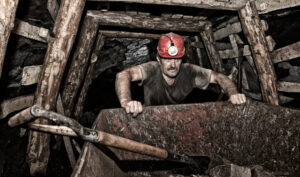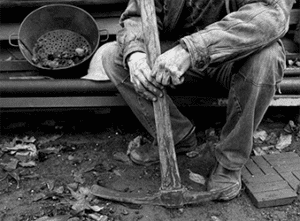Before the dangers of asbestos were known to the public, many workers in the mining industry regularly came into contact with this substance as it was removed from the earth. This put miners at risk of asbestos-related illnesses like mesothelioma. Get help if you're a miner suffering from mesothelioma.
Mesothelioma and Miners Explained
Asbestos is a naturally occurring mineral that must be extracted from the ground if it is to be used in products like insulation. Asbestos miners were tasked with retrieving this substance.
Unfortunately, asbestos exposure is now known to cause mesothelioma, asbestosis, lung cancer, and other diseases. Asbestos miners were put at risk of exposure on a daily basis before the 1980s (as the risks of asbestos weren't well-known until then).
As miners worked to remove asbestos, microscopic fibers could have been kicked up into the air. Any miner that inhaled or swallowed the fibers could get sick with mesothelioma later in life. Both miners who served in the U.S. military and civilian miners are in danger.
If you or your family were exposed to asbestos from mines and got sick, you may be able to get medical care and financial compensation . Get our Free Veterans Packet to see how.
Dangers of Asbestos Exposure From Mines
 Asbestos not only put miners at risk, but it also impacted those who lived near an asbestos mine. Many who lived in neighborhoods and towns close to asbestos mines have been diagnosed with various asbestos-related diseases decades later.
Asbestos not only put miners at risk, but it also impacted those who lived near an asbestos mine. Many who lived in neighborhoods and towns close to asbestos mines have been diagnosed with various asbestos-related diseases decades later.
The asbestos particles could rise up from the mines and become airborne, putting anyone living in the immediate area at risk of inhaling this toxic substance.
Horrifyingly, asbestos mining was commonplace throughout the United States and the rest of the world for decades before the dangers were known.
Asbestos mining occurred in:
- California
- Connecticut
- Georgia
- Maryland
- Massachusetts
- Minnesota
- Montana
- North Carolina
- Oregon
- Pennsylvania
- Vermont
- Virginia
In fact, a town in Quebec, Canada was once named "Asbestos" due to a local mine that contained the substance.
Asbestos is no longer mined in the U.S. today, but miners exposed decades ago continue to be diagnosed with mesothelioma each year. This is because it takes 10-50 years for this cancer to develop after asbestos exposure.
Libby, Montana Asbestos Mine Disaster
The dangers of asbestos exposure from mines were made clear due to a public health crisis in Libby, Montana. Asbestos that was kicked up from a local mine traveled through the air to the town, exposing almost all of the residents.
There have been over 400 deaths and 2,400 diagnoses of asbestos-related diseases among residents of Libby. The population of the town has never been higher than 3,000. 1 in 10 Libby residents currently has an asbestos-related disease.
To handle all of the health issues, the Center for Asbestos-Related Diseases (CARD) was established in the town. CARD provides medical care to those affected by asbestos-caused health problems stemming from the mine.
Secondhand Asbestos Exposure From Mines
Miners also unknowingly brought asbestos home with them on their clothing after working in the mines, as stray fibers could stick to clothes or hair.
Family members of asbestos miners are at a high risk of mesothelioma and other asbestos-related illnesses due to this secondhand exposure.
Asbestos in Coal Mines
On top of these other concerns like inhaling coal dust and cave-ins, coal miners may have also been exposed to asbestos.
 Not all coal mines are laced with asbestos, but about 15% are contaminated by asbestos dust. This means that contractors, refinery workers, and miners could all have been exposed to asbestos.
Not all coal mines are laced with asbestos, but about 15% are contaminated by asbestos dust. This means that contractors, refinery workers, and miners could all have been exposed to asbestos.
Coal may have had asbestos particles embedded into it. As a result, the process of handling, grinding, cutting, and crushing coal yields asbestos particles and coal dust particles. This puts coal miners at just as high of a risk for asbestos dust exposure as they have for coal dust.
Coal mining operations in several states have been known to be responsible for asbestos exposure.
Some states with asbestos-containing coal mines include:
- Arkansas
- Arizona
- Illinois
- Kentucky
- Minnesota
- Ohio
- Tennessee
- Virginia
- West Virginia
It is important to remember that it is not just the coal miners who are being exposed to asbestos—anyone living near a coal mine or with family members who were coal miners is at risk of mesothelioma too.
Mining Equipment & Asbestos Risks
Miners weren’t just at risk from asbestos in the product being mined. Asbestos was also used in much of the equipment miners used to do their jobs.
Equipment that put miners at risk of asbestos exposure include:
- Brake linings
- Clutches
- Continuous mining machines
- Hoist machines
- Motor controls
- Pipe insulation
- Shuttle cars
- Transit panels
- Welding blankets
- Winches
These products often contained asbestos to ensure they were durable and resistant to heat.
Benefits for Miners with Mesothelioma
If you or a loved one is a miner exposed to asbestos and suffering from mesothelioma, you may be able to receive benefits like medical aid and financial payouts.
You can get help and compensation through:
- VA benefits: If you're a miner who served in the military and later developed mesothelioma, you may qualify for benefits from the U.S. Department of Veterans Affairs (VA). These benefits include low-cost or free medical treatment and payouts worth almost $4,000 a month as of 2024.
- Mesothelioma lawsuits: The health risks of asbestos exposure may be well known now, but for decades these dangers were hidden by companies. You can file a private mesothelioma claim to get compensation from these companies. In 2023, a former Libby miner with asbestos-related health problems received $36.5 million through a private claim.
- Asbestos trust funds: Some asbestos companies attempted to declare bankruptcy to avoid being sued for the harm they caused. However, courts forced these companies to create trust funds to pay victims. these trust funds currently have over $30 billion set aside for victims.
Our team can help you file for mesothelioma VA benefits and other forms of assistance now.
Help for Miners with Mesothelioma
If you're a miner suffering from mesothelioma, know that help is available. The Mesothelioma Veterans Center has a team dedicated to helping both veteran and civilian miners navigate life after an asbestos-related diagnosis.
We can help you access:
- Financial aid
- Top treatments from skilled doctors
- VA benefits
- Other important resources
Get a Free Veterans Packet to see all the ways we can help you.
FAQs About Mesothelioma and Miners
How much asbestos exposure can cause mesothelioma in miners?
There is no safe level of asbestos exposure. Even a single asbestos fiber can trigger health problems later in life.
Any asbestos exposure greater than 0.1 fiber per cubic centimeter is considered dangerous, according to the United States Mine Safety and Health Administration (MSHA).
The awful truth is that minters were exposed to much more than this for decades. Prior to the 1980s, the risks of asbestos were largely hidden by corporations, meaning miners were exposed to high amounts on a daily basis.
As late as 2005, miners were exposed to asbestos at a rate of 2 fibers per cubic centimeter — roughly 20 times above the threshold for “safe” asbestos exposure.
Do all asbestos miners get mesothelioma?
No. Asbestos miners can develop several types of asbestos-related illnesses besides mesothelioma. These include asbestosis, lung cancer, or pleural plaques.
Further, some asbestos miners might not ever develop an asbestos-related disease.
However, being exposed to asbestos on a regular basis in mines greatly increases the odds of getting sick.
Do coal miners get mesothelioma?
Yes. Coal miners are at a heightened risk of mesothelioma and other asbestos-related diseases, as some coal mines were contaminated with this deadly substance.
Call (877) 450-8973 now if you have mesothelioma and worked in a coal mine decades ago. We may be able to help you.


